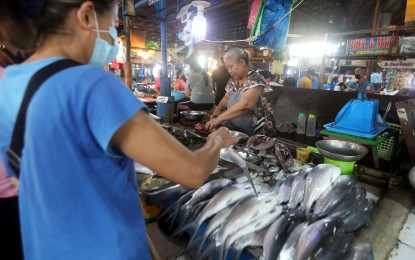
PNA photo by Oliver Marquez
MANILA – The consumer price index (CPI) for September this year rose 6.9 percent, which is mainly driven by faster food inflation, the Philippine Statistics Authority (PSA) reported Wednesday.
In a press conference, PSA head and national statistician Undersecretary Dennis Mapa said the headline inflation last month was higher than the 6.3-percent rate in August 2022 and the 4.2-percent CPI in September 2021.
Last month’s figure brought the average inflation rate from January to September this year to 5.1 percent.
Mapa said nine out of 13 commodity groups recorded higher inflation rate last month. Top contributors to the faster pace in price increases were food and non-alcoholic beverages; housing, water, electricity, gas and other fuels; and transport.
He said food and non-alcoholic beverages inflation climbed to 7.4 percent in September from 6.3 percent in August 2022.
The price increases in the food basket contributed 40.8 percent to the total inflation last month.
Amid the sugar woes in the previous months, the pace of price increase of sugar, confectionery, and desserts stood at 30.2 percent in September from 26 percent in August.
Inflation rate of fish and other seafood also rose to 9.1 percent in September from 7.2 percent in August, while increase in prices of vegetables, tubers and the likes recorded an inflation of 3.5 percent in September from a contraction of 2.7-percent in August.
Housing, water, electricity, gas and other fuels sub-group is the second highest contributors to September inflation, with a share to the uptrend of around 22.8 percent.
Inflation rate of this sub-group last month increased to 7.3 percent from 6.8 percent in August, with power rates increases rising to 21.4 percent in September from 19.1 percent in August.
The third major contributor to higher inflation in September was transport cost, with an inflation rate of 14.5 percent, contributing 19.1 percent to the faster rate of price increases.
Other commodity groups which had higher inflation rate in the previous month include alcoholic beverages and tobacco at 9.8 percent; clothing and footwear at 2.9 percent; furnishings, household equipment, and routine household maintenance at 3.5 percent; information and communication at 0.5 percent; recreation, sport, and culture at 2.7 percent; restaurants and accommodation services at 4.6 percent; and personal care, and miscellaneous goods and services at 3.4 percent.
Faster price increase outside NCR
While the National Capital Region (NCR) recorded a 6.5-percent national inflation rate last month, the pace of price increments in areas outside NCR (AONCR) was higher than NCR and national level at 7 percent.
Fifteen regions AONCR recorded higher inflation rate in September, with fastest price increases reported in Zamboanga Peninsula and Davao Region both at 9.6 percent.
It was noted that while inflation for rice in NCR decelerated to 0.2 percent in September from a 0.8-percent increment in August, rice inflation in AONCR went up to 2.8 percent last month from 2.4 percent in August.
Risks of higher inflation remain
Mapa said risks of faster increase in prices of goods and services remain throughout the year amid the impacts of Super Typhoon Karding that destroyed agricultural products, the approved fare hike in public transportation, the effect of peso depreciation to pump prices that has spillover impact to food and transport costs, and the expected higher demand during the ‘ber’ months.
“Risk of future inflation will really come from the food group,” he said. “Reducing inflation would really mean reducing food inflation.”
He added that although the trend is moving up, there are also factors that could contribute to taming the inflation in the coming months.
Mapa said it was in 2009 that the country hit an inflation rate of 7.2 percent.
During the global financial crisis, the national CPI peaked at 10.5 percent in August 2008, he said. (PNA)
